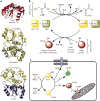Biogenesis of reactive sulfur species for signaling by hydrogen sulfide oxidation pathways
- PMID: 26083070
- PMCID: PMC4818113
- DOI: 10.1038/nchembio.1834
Biogenesis of reactive sulfur species for signaling by hydrogen sulfide oxidation pathways
Abstract
The chemical species involved in H2S signaling remain elusive despite the profound and pleiotropic physiological effects elicited by this molecule. The dominant candidate mechanism for sulfide signaling is persulfidation of target proteins. However, the relatively poor reactivity of H2S toward oxidized thiols, such as disulfides, the low concentration of disulfides in the reducing milieu of the cell and the low steady-state concentration of H2S raise questions about the plausibility of persulfide formation via reaction between an oxidized thiol and a sulfide anion or a reduced thiol and oxidized hydrogen disulfide. In contrast, sulfide oxidation pathways, considered to be primarily mechanisms for disposing of excess sulfide, generate a series of reactive sulfur species, including persulfides, polysulfides and thiosulfate, that could modify target proteins. We posit that sulfide oxidation pathways mediate sulfide signaling and that sulfurtransferases ensure target specificity.
Conflict of interest statement
The authors declare no competing financial interests.
Figures






References
-
- Russell MJ, Hall AJ. The emergence of life from iron monosulphide bubbles at a submarine hydrothermal redox and pH front. J Geol Soc Lond. 1997;154:377–402. - PubMed
-
- Wacey D, Kilburn MR, Saunders M, Cliff J, Brasier MD. Microfossils of sulphur-metabolizing cells in 3.4-billion-year-old rocks of Western Australia. Nat Geosci. 2011;4:698–702.
-
- Anbar AD, Knoll AH. Proterozoic ocean chemistry and evolution: a bioinorganic bridge? Science. 2002;297:1137–1142. - PubMed
-
- Li C, et al. A stratified redox model for the Ediacaran ocean. Science. 2010;328:80–83. - PubMed
-
- Grice K, et al. Photic zone euxinia during the Permian-Triassic superanoxic event. Science. 2005;307:706–709. - PubMed
Publication types
MeSH terms
Substances
Grants and funding
LinkOut - more resources
Full Text Sources
Other Literature Sources

